多环芳烃(PAHs)是典型的持久性有机污染物。据2017年的统计,PAHs全球的年排放量可达到50.2万吨,中国每年排放约15万吨PAHs。PAHs具有致癌、致畸、致突变等“三致”效应,其造成的土壤污染问题受到世界各国的强烈关注[1-3]。美国环境保护署(USEPA)已将16种PAHs列入优先控制污染物名单,我国生态环境部在优先控制污染物名单中也列出了7种PAHs[4]。表 1总结了16种PAHs的结构和理化性质。从表 1可看出,随着分子量的增大,PAHs芳环数量增加,水溶性明显降低。目前,我国已建立基于农产品和人居环境安全的风险管控标准,然而基于生态安全的土壤风险筛选值和管控标准仍未确立,造成土壤生态安全风险的评估仍无据可依的窘境。因此,加强生态安全土壤环境基准研究,对更好地防控土壤PAHs污染、评估其生态风险具有十分重要的意义。
|
|
表 1 16种USEPA PAHs结构及性质 Table 1 Structure and properties of 16 USEPA PAHs |
有机污染物PAHs等污染物的生态安全土壤环境基准是科学制定其土壤风险筛选值的基础[5-7]。学者们开发了多种方法用以建立生态安全土壤环境基准,其中运用广泛的有物种敏感性分布法(Species sensitive distribution,SSD)、评估因子法(Assessment factor,AF)和相平衡分配法(Equilibrium partitioning approach,EqPA)3种[8-11]。3种方法各有对应的应用范围,当污染物毒性数据库足够丰富(通常指有10~15个以上,包含至少8个不同生物种类的毒性数据)时,适用于SSD法;当毒性数据库的生物种类和营养级别单一,且数据库较小(不超过10个)时,可选择AF法;当污染物陆生生物的毒性数据库缺失时,可考虑采用EqPA法。AF法和EqPA法较为简单,且毒性数据库较小[12],其推导建立的土壤环境基准误差较大。基于SSD曲线的统计学外推法首先根据剂量–效应关系估算污染物毒性效应数据,分别依据生态物种和生态过程的最佳拟合函数曲线计算不同生态保护水平下的危害浓度(x% Hazardous concentration,HCx),并选择不同的外推方法估算预测无效应浓度(Predicted no-effect concentration,PNEC),将获得的PNEC值用于生态安全土壤环境基准值的推导和建立[13-16]。
本研究针对我国土壤PAHs的污染现状,系统调研和筛选国内外PAHs的生态毒性效应数据,构建PAHs生态毒性数据库,采用SSD法推导16种优先控制PAHs的生态安全土壤环境基准,以期为我国土壤的生态风险评估及土壤生态环境质量标准的制定提供数据支撑和参考。
1 材料与方法 1.1 土壤PAHs毒性效应数据筛选与处理PAHs毒性效应数据主要选自国内外已出版发行的数据库和文献资料。PAHs毒性数据库来源主要包括美国环保署的ECOTOX毒性数据库(https://cfpub.epa.gov/ecotox)、爱思唯尔(https://www.sciencedirect.com)、斯普林格(https://link.springer.com)、Web of Science(http://www.isiknowledge.com)、中国知网(http://www.cnki.net)和荷兰国家公共卫生与环境研究所(RIVM)出版的相关文献资料(https://www.rivm.nl/en)等。PAHs毒性终点的选择优先参考国标(GB/T 27851— 2011[17];GB/T 31270.19—2014[18];GB/T 21809— 2008[19];GB/T 31270.15—2014[20];GB/T 27854— 2011[21];GB/T 27855—2011[22];GB/T 31270.16— 2014[23])推荐指标,若文献中无国标推荐指标,则选择OECD或ISO土壤质量评价推荐指标。对于同一供试土壤、同一物种得到的毒性效应数据,取其几何平均值作为毒性数据。此外,本研究中PAHs的毒性效应浓度均根据外源添加量计算得到,不包括试验土壤本底值部分,并选择依据剂量–效应关系推导出的EC10/NOEC(10%效应浓度/无观察效应浓度)作为毒性数据,同时收集试验土壤的理化性质数据。
从34篇英文文献和10篇中文文献中筛选到9种PAHs毒性数据,其余7种未收集到的PAHs毒性数据(表S1),采用毒性当量因子(Toxic equivalent factor,TEF)转换得到:选择苯并[a]芘(Benzo[a]pyrene)作为基底参照物,设定其TEF值为1,7种未收集到的苊(Acenaphthylene)、䓛(Chrysene)、苯并[b]荧蒽(Benzo[b]fluoranthene)、苯并[k]荧蒽(Benzo[k]fluoranthene)、二苯并[a,h]蒽(Dibenz[a,h]anthracene)、苯并[g,h,i]苝(Benzo[g,h,i]perylene)和茚并[1,2,3-cd]芘(Indeno[1,2,3-cd]pyrene)的TEF值分别是0.001、0.01、0.1、0.1、1、0.01、0.1[24]。同时将来源于不同理化性质土壤的PAHs毒性数据进行归一化处理,标准土壤的性质为pH = 6.5、土壤有机质(Soil organic matter,SOM)含量为20 g·kg–1[25],归一化公式[25]如下:
| $ {\text{EC}}_{\text{X}}^{{\text{std}}} = {\text{EC}}_{\text{X}}^{\text{1}} \times {10^{{\text{a}}({\text{p}}{{\text{H}}^{{\text{std}}}} - {\text{p}}{{\text{H}}^1}) + {\text{b}}{{\log }_{10}}\left( {\frac{{{\text{SO}}{{\text{M}}^{{\text{std}}}}}}{{{\text{SO}}{{\text{M}}^1}}}} \right)}} $ |
式中,
选择常见的累积分布函数(Burr Ⅲ、Logistic、Log-normal、Log-logistic、Gamma和Weibull,表 2)拟合所筛选物种的EC10/NOEC等毒性数据,获取PAHs的SSD曲线并比较其拟合精度。土壤生态保护水平的设定是影响基于毒性数据累计概率分布方法推导生态安全土壤环境基准的重要因素。本研究中生态保护水平的划分参考了2018年中国生态环境部印发的《生态安全土壤环境基准制定技术指南(征求意见稿)》[25]。依据得到的最优拟合函数曲线计算不同生态保护水平下(p)的危害浓度HC(1-p),不同土地利用方式下的生态物种及生态过程保护水平与危害浓度对应如下:自然保护地和农用地下需保护95%的生态物种和生态过程(HC5);公园用地要求保护80%生态物种和生态过程,此时危害浓度为HC20;住宅用地下保护60%生态物种和生态过程时的危害浓度是HC40;商服及工业用地下保护50%生态物种和生态过程时的危害浓度是HC50。
|
|
表 2 累积分布函数 Table 2 Cumulative distribution function for SSD curve |
从数据库和相关文献中筛选出248组包含9种PAHs的生物毒性效应数据(图 1,图 2),菲和芘的数据量最多,分别为57组和55组,荧蒽和苯并[a]芘的数据量次之,分别为29组和30组。其他数据量包括萘19组、二氢苊6组、芴24组、蒽17组、苯并[a]蒽11组。9种PAHs具体数据情况如下:萘最小的毒性数据为2.70 mg·kg–1,来源于白符跳(Folsomia candida),最大的毒性数据为101.50 mg·kg–1,从小白菜(Brassica campestris)中测出,两者相差近40倍。二氢苊的毒性数据主要来源于莴苣(Lactuca sativa)和跳虫(Folsomia fimetaria),浓度范围是1~76 mg·kg–1。芴的暴露浓度最大,为1 029 mg·kg–1,24个收集到的毒性数据的均值为81.94 mg·kg–1,其中,跳虫(Folsomia fimetaria)的敏感性最高。菲收集了57个生物毒性数据,是所有PAHs中最多的,浓度范围为6.14~827 mg·kg–1,平均浓度77.89 mg·kg–1。蒽最小的毒性数据为3.60 mg·kg–1,来源于跳虫(Folsomia fimetaria),17组毒性数据的平均浓度为350.12 mg·kg–1。芘最小的毒性数据是从白符跳(Folsomia candida)中测出的1.60 mg·kg–1,最大毒性数据是赤子爱胜蚓(Eisenia fetida)的1 000 mg·kg–1。荧蒽最小的毒性数据是油菜(Brassica napus)的3.04 mg·kg–1,最大毒性数据是鼠妇(Porcellio scaber)的801 mg·kg–1。苯并[a]蒽最小的毒性数据出自栉水虱(Oniscus asellus),为7.40 mg·kg–1,最大毒性数据是跳虫(Folsomia fimetaria)的990 mg·kg–1。苯并[a]芘的毒性数据范围是1~947 mg·kg–1,平均浓度为258.65 mg·kg–1,且赤子爱胜蚓(Eisenia fetida)在所有受试物种中敏感性最高。
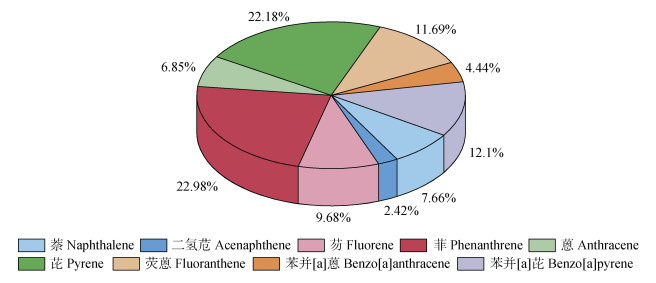
|
图 1 从文献中统计的PAHs毒性数据量 Fig. 1 Volume of PAHs toxicity data collected from the literature |
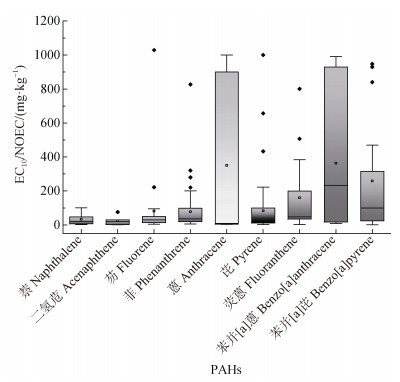
|
图 2 PAHs的暴露浓度 Fig. 2 Exposure concentration of PAHs |
选择毒性数据量较大的菲、芘和苯并[a]芘三种PAHs,作为低、中、高环PAHs的典型代表,研究PAHs毒性数据与供试土壤理化性质的关系。如图 3所示,供试土壤pH与菲(r = 0.360,P = 0.009)、芘(r = 0.379,P = 0.006)和苯并[a]芘(r = 0.611,P = 0.005)的毒性数据呈明显的正相关,这可能是因为较低的土壤pH条件提高了PAHs的生物有效性,即在酸性土壤中较低的PAHs浓度便可引起生物体较强的毒性效应,从而使所得出的EC10/NOEC较低。SOM含量与菲(r = 0.323,P = 0.015)、芘(r= 0.060,P = 0.672)和苯并[a]芘(r = 0.412,P = 0.079)呈现正相关,可能是因为SOM含量的提高,降低生物有效态PAHs的含量,需要更多PAHs才能引起生物体的毒性效应,从而增大了EC10/NOEC。
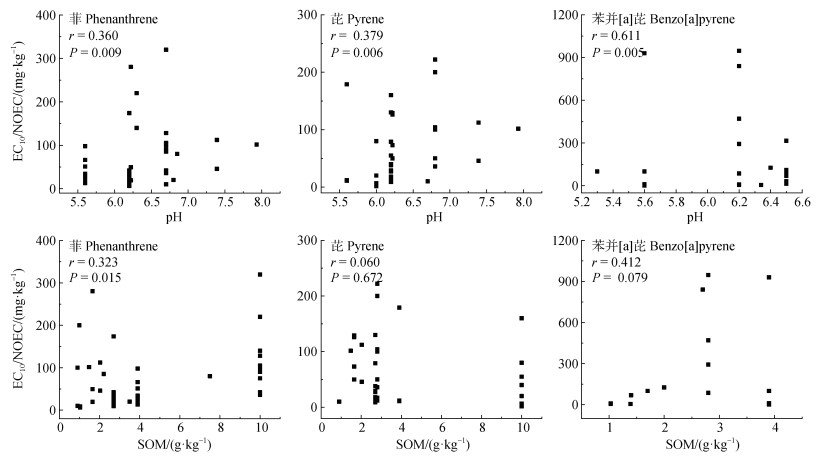
|
图 3 菲、芘和苯并[a]芘的毒性数据与供试土壤理化性质的关系 Fig. 3 Relationship between toxicity data of phenanthrene, pyrene and benzo[a]pyrene and soil properties |
采取常见的几种模型对土壤中16种PAHs的毒性效应数据进行拟合,发现仅模型Burr III和Logistic拟合收敛,两模型的拟合结果见图 4,两模型对毒性效应数据的拟合优度如表 3所示。由表 3可看出,Burr III和Logistic模型均能成功拟合收集的16种PAHs的毒性效应数据,Burr III模型对苊、芘和苯并[a]蒽等毒性数据的拟合参数R2高于Logistic模型,说明Burr III模型的拟合度更好。Logistic模型对其余13种PAHs的毒性效应数据拟合效果更佳。因此,后续推导过程使用Burr III模型拟合苊、芘和苯并[a]蒽的毒性效应数据,选用Logistic模型拟合其余13种PAHs的毒性效应数据。模型Burr III和Logistic拟合的SSD曲线存在一定的差异,可能导致推导出的基准值有所差异。如萘的SSD曲线的前部分中,模型Logistic的拟合曲线位于模型Burr III的拟合曲线上方,导致模型Burr III推导的基准值更为保守,同样的现象在荧蒽、䓛和苯并[g,h,i]苝中也有体现。
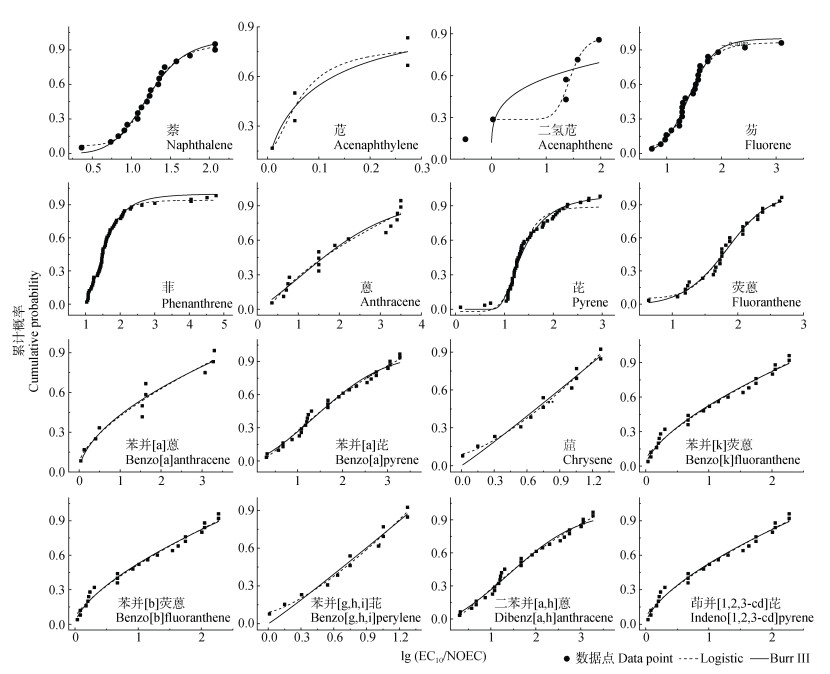
|
图 4 土壤中PAHs的物种敏感性分布曲线 Fig. 4 Species sensitivity distribution curves of PAHs in soil |
|
|
表 3 Burr III和Logistic模型对PAHs毒性数据的拟合优度检验 Table 3 Goodness-of-fit test of Burr III and Logistic models for PAHs toxicity data |
在确定土壤生态风险筛选值时,要根据具体的用地方式来确定当前地块的PAHs生态安全环境基准值。本研究优选拟合效果最好的SSD模型推导出USEPA各PAH不同用地方式(p)下的HC(1-p)值。如表 4所示,自然保护地和农用地土壤中各PAH的生态基准范围为1.00~10.60 mg·kg–1;公园用地土壤中各PAH的生态基准范围为1.03~25.44 mg·kg–1;住宅用地土壤中各PAH的生态基准范围为1.12~51.00 mg·kg–1;商服及工业用地土壤中各PAH的生态基准范围为1.20~68.41 mg·kg–1。可以看出随着用地方式要求的逐渐放宽,各PAH的土壤环境基准值也会有一定的增加。进一步分析各PAH基准值与分子芳环数量之间的关系(图 5)。以公园用地方式为例,各PAH的生态安全土壤环境基准与芳环数呈线性负相关关系(r = 0.309,P = 0.245),这也与芳环数目越多,其毒性越大的共识一致。
|
|
表 4 不同用地方式下各PAH的生态安全土壤环境基准 Table 4 Soil environmental criteria for ecological safety of each PAH in different land use types |
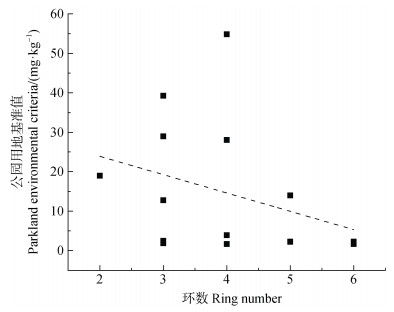
|
图 5 公园用地中各PAH的生态安全土壤环境基准与其环数的关系 Fig. 5 Relationship between soil environmental criteria for ecological safety and ring number of each PAH in the parkland |
发达国家对土壤环境基准的研究开展较早,早在20世纪70年代荷兰就起草了《土壤保护法》,随后也不断完善相关法律条文[26-27]。USEPA在2000年,正式发布了《土壤筛选值指南:草案》,对土壤筛选值的制订背景、意义以及制定过程均进行了详细说明,并提出了基于生态风险评估的土壤筛选值[28]。加拿大环境部长理事会在1996年发布了推导污染场地土壤质量指导值的技术手册,将土地利用方式分为了4类(农业用地、居住/公园用地、商业用地和工业用地),该指导值包括保护人类健康和保护环境两类[29]。英国环境署于2004年正式发布《土壤筛选值在英国生态风险评价中的应用》,后续还发表了一些与土壤风险筛选值相关的研究报告[30]。荷兰住房、空间规划和环境部采用基于生态风险的土壤环境质量标准来评估待规划土壤的污染程度以及是否需要采取风险管控和修复,包括目标值、行动值和介于两者之间的筛选值[31]。我国已于2018年发布《土壤环境质量农用地土壤污染风险管控标准(试行)》(GB/T 15618—2018)[32]和《土壤环境质量建设用地土壤污染风险管控标准(试行)》(GB/T 36600—2018),并提出了风险筛选值和风险管控值的概念,以对应不同土壤的风险分类[33],当前正在开展生态安全土壤环境基准的建立工作。本研究推导的PAHs基准值大多与《建设用地土壤污染风险管控标准》的风险筛选值相近,证明所建立基准的可信性。但也有相差较大的结果,例如,《建设用地土壤污染风险管控标准》第一类和第二类用地中䓛的风险筛选值分别为490 mg·kg–1和1 293 mg·kg–1,是本研究结果的100倍左右。
根据各国的实际情况,在生态安全土壤环境基准推导方法上的选择也有所不同,这也是各国的土壤基准存在较大差异的原因之一。美国采取几何平均法推导土壤环境基准值,而英国、荷兰和澳大利亚优先选择SSD法推导土壤环境基准值,此外还有部分国家采用标准土壤校正,统一土壤标准来推导土壤环境基准值。与其他方法相比,SSD法可以由敏感物种毒性实验结果预测污染物在生态系统中的潜在危险,准确性也较高,是一种比较科学的土壤生态环境基准推导方法,被广泛运用到土壤生态基准的建立研究中。如孙在金等[34]在推导土壤锑环境基准时使用了SSD法;李勖之等[35]应用SSD法建立了土壤铅的生态安全土壤环境基准;林荣华等[36]在农药环境风险评估中也采用了SSD法。在土壤PAHs生态风险评估与生态基准研究中,常见的有污染程度指数、风险熵值法、生态风险效应区间低值和效应区间中值[37-39],但SSD法应用的案例较少。焦婷婷[40]在黄棕壤和潮土中利用生态环境效应法,以青菜地上部生物量减少10%为毒性终点,通过拟合“浓度-产量”效应方程,推导出农用地荧蒽的生态基准分别为16.17 mg·kg–1和2.43 mg·kg–1;以15%的蚯蚓生长抑制率为毒性终点,所得的农用地生态基准分别为9.26 mg·kg–1和11.53 mg·kg–1,与本研究所得基准值相当。
3.2 生态安全土壤环境基准推导的不确定性分析生态安全土壤环境基准推导的不确定性不仅来自毒性数据的数量与筛选、累积分布函数的拟合精度和用地方式,还可能源于自然环境中污染物暴露水平的差异。鉴于此,常引入蒙特卡罗模型进行模拟来降低基准推导过程中的不确定性。蒙特卡罗模拟可以将暴露途径和参数同一定的概率模型相关联,模拟实际的物理过程,并以变异系数(Coefficient of variation,CV)用作比较毒性和暴露数据不确定性的指标[41]。Qin等[42]比较了基于5 000次蒙特卡罗模拟的8种PAHs毒性数据和暴露数据的CV值。结果表明,8种PAHs毒性数据的CV值较大,为1.14~6.92,而实际暴露数据的CV值为0.28~0.36。可见毒性数据的不确定性可能是土壤生态风险与基准推导不确定性的主要来源。为尽量降低推导出的PAHs生态安全土壤环境基准的不确定性,本研究广泛搜集了国际主流数据库和权威文献资料,增加PAHs毒性数据的样本量,降低样本数量不足而带来的不确定性;为确保毒性数据的准确性,在筛选数据时充分考虑了毒性试验过程是否满足相关标准方法,毒性终点是否合理等因素;同时还综合考虑了土壤的生态服务功能和管理方式的差异,制定了多种生态保护水平下的PAHs土壤环境基准。因此,本研究建立的PAHs生态安全土壤环境基准具有一定的合理性和指导性。
此外,在收集土壤PAHs生态毒性数据的过程中发现,国内土壤中PAHs的生态毒性效应数据量较少,本研究选择的PAHs毒性效应数据大部分源于国外数据库和文献资料。同时由于土壤类型和敏感性物种种类的差异,国外的毒性数据可能与国内研究结果有一定差异,本研究建立的土壤环境基准也可能存在误差。同时我国地域广大、土壤类型多样、生物种类繁多,这些都是推导生态安全土壤环境基准时必需考虑的因素,否则也会导致建立土壤生态环境基准过程的不确定性。可见,典型土壤中代表性物种的PAHs毒性效应数据缺失已经成为科学、准确制定生态安全土壤环境基准的难题。未来我国需尽快开展土壤PAHs的生态毒性实验,获取典型土壤中代表性物种的PAHs毒性效应数据,破解PAHs毒性效应数据缺失的问题。
4 结论本研究共收集和筛选了包含9种PAHs的248组毒性数据,并采用毒性当量因子法转换获得其余7种毒性数据。土壤pH和SOM含量分别与菲、芘和苯并[a]芘的毒性数据呈正相关。优选Burr III和Logistic模型分别拟合了16种US PAHs的物种敏感性分布曲线,最终推导出不同用地方式下各PAH的生态安全土壤环境基准,分别为1.00~10.60 mg·kg–1(自然保护地和农用地)、1.03~25.44 mg·kg–1(公园用地)、1.12~51.00 mg·kg–1(住宅用地)、1.20~68.41 mg·kg–1(商服及工业用地)。该研究结果可为我国PAHs生态安全土壤环境质量标准的建立提供数据和理论支撑。
| [1] |
Fernández S F, Pardo O, Hernández C S, et al. Children's exposure to polycyclic aromatic hydrocarbons in the Valencian Region(Spain): Urinary levels, predictors of exposure and risk assessment[J]. Environment International, 2021, 153: 106535. DOI:10.1016/j.envint.2021.106535
(  0) 0) |
| [2] |
Chen Z G, Tian Z X, Liu X H, et al. The potential risks and exposure of Qinling giant pandas to polycyclic aromatic hydrocarbon(PAH) pollution[J]. Environmental Pollution, 2022, 292: 118294. DOI:10.1016/j.envpol.2021.118294
(  0) 0) |
| [3] |
Ma L, Li Y H, Yao L, et al. Polycyclic aromatic hydrocarbons in soil-turfgrass systems in urban Shanghai: Contamination profiles, in situ bioconcentration and potential health risks[J]. Journal of Cleaner Production, 2021, 289: 125833. DOI:10.1016/j.jclepro.2021.125833
(  0) 0) |
| [4] |
Schoeny R, Poirier K. Provisional guidance for quantitative risk assessment of polycyclic aromatic hydrocarbons[R]. Washington: EPA, 1993.
(  0) 0) |
| [5] |
Zhao X L, Zhao T H, Li H X, et al. Investigation on important directions of China environmental quality criteria (In Chinese)[J]. Asian Journal of Ecotoxicology, 2015, 10(1): 18-30. [赵晓丽, 赵天慧, 李会仙, 等. 中国环境基准研究重点方向探讨[J]. 生态毒理学报, 2015, 10(1): 18-30.]
(  0) 0) |
| [6] |
Teng Y, Zhou Q X. Conversion relationships between environmental quality criteria of water/air and soil (In Chinese)[J]. Scientia Sinica: Terrae, 2018, 48(11): 1466-1477. [滕涌, 周启星. 土壤环境质量基准与水/大气环境质量基准的转换研究[J]. 中国科学: 地球科学, 2018, 48(11): 1466-1477.]
(  0) 0) |
| [7] |
Zheng L P, Long T, Feng Y H, et al. Environmental quality criteria for lead in soil based on ecological risk (In Chinese)[J]. Journal of Ecology and Rural Environment, 2016, 32(6): 1030-1035. [郑丽萍, 龙涛, 冯艳红, 等. 基于生态风险的铅(Pb)土壤环境基准研究[J]. 生态与农村环境学报, 2016, 32(6): 1030-1035.]
(  0) 0) |
| [8] |
Zhou Q X. Advances and prospect of research on environmental criteria/benchmarks and enactment of environmental standards (In Chinese)[J]. Journal of Ecology and Rural Environment, 2010, 26(1): 1-8. DOI:10.3969/j.issn.1673-4831.2010.01.001 [周启星. 环境基准研究与环境标准制定进展及展望[J]. 生态与农村环境学报, 2010, 26(1): 1-8.]
(  0) 0) |
| [9] |
Xu F L, Li Y L, Wang Y, et al. Key issues for the development and application of the species sensitivity distribution(SSD) model for ecological risk assessment[J]. Ecological Indicators, 2015, 54: 227-237. DOI:10.1016/j.ecolind.2015.02.001
(  0) 0) |
| [10] |
Gredelj A, Barausse A, Grechi L, et al. Deriving predicted no-effect concentrations(PNECs) for emerging contaminants in the River Po, Italy, using three approaches: Assessment factor, species sensitivity distribution and AQUATOX ecosystem modelling[J]. Environment International, 2018, 119: 66-78. DOI:10.1016/j.envint.2018.06.017
(  0) 0) |
| [11] |
Van den Brink P J, Buijert-de Gelder D M, Brock T C M, et al. Exposure pattern-specific species sensitivity distributions for the ecological risk assessments of insecticides[J]. Ecotoxicology and Environmental Safety, 2019, 180: 252-258. DOI:10.1016/j.ecoenv.2019.05.022
(  0) 0) |
| [12] |
Staples C A, Woodburn K B, Klecka G M, et al. Comparison of four species sensitivity distribution methods to calculate predicted no effect concentrations for Bisphenol A[J]. Human and Ecological Risk Assessment, 2008, 14(3): 455-478. DOI:10.1080/10807030802074170
(  0) 0) |
| [13] |
Sun C, Chen S B, Ma Y B, et al. Ecological hazard concentration(HC5) of cadmium(Cd) to rice cultivars under hydroponic culture as determined with species sensitivity distribution model(Burr-Ⅲ) (In Chinese)[J]. Journal of Agro-Environment Science, 2013, 32(12): 2316-2322. DOI:10.11654/jaes.2013.12.002 [孙聪, 陈世宝, 马义兵, 等. 基于物种敏感性分布(Burr-Ⅲ)模型预测Cd对水稻毒害的生态风险阈值HC5[J]. 农业环境科学学报, 2013, 32(12): 2316-2322.]
(  0) 0) |
| [14] |
Dou W Q, An Y, Qin L, et al. Research progress in determination methods of ecological safety thresholds for heavy metals in agricultural land (In Chinese)[J]. Asian Journal of Ecotoxicology, 2019, 14(4): 54-64. [窦韦强, 安毅, 秦莉, 等. 农用地土壤重金属生态安全阈值确定方法的研究进展[J]. 生态毒理学报, 2019, 14(4): 54-64.]
(  0) 0) |
| [15] |
Yan S, Zhou Q X, Gao J. Methodology for derivation of water quality criteria for protecting aquatic environment and future development[J]. Critical Reviews in Environmental Science and Technology, 2012, 42(23): 2471-2503. DOI:10.1080/10643389.2011.592738
(  0) 0) |
| [16] |
Dong M M, Mou L Y, Qin L, et al. Evaluation of the goodness of fit of the species sensitivity distribution fitting function (In Chinese)[J]. Journal of Agro-Environment Science, 2021, 40(3): 544-551. [董明明, 牟力言, 秦莉, 等. 物种敏感性分布法拟合函数的拟合优度评价[J]. 农业环境科学学报, 2021, 40(3): 544-551.]
(  0) 0) |
| [17] |
General Administration of Quality Supervision, Inspection and Quarantine of the People's Republic of China. Chemicals-Terrestrial plant test-Vegetative vigour test: GB/T 27851—2011[S]. Beijing: General Administration of Quality Supervision, Inspection and Quarantine of the People's Republic of China, 2011.[中华人民共和国国家质量监督检验检疫总局. 化学品陆生植物生长活力试验: GB/T 27851—2011[S]. 北京: 国家质量监督检验检疫总局, 2011.]
(  0) 0) |
| [18] |
General Administration of Quality Supervision, Inspection and Quarantine of the People's Republic of China, Standardization Administration of the People's Republic of China. Test guidelines on environmental safety assessment for chemical pesticides—Part 19: Effects on non-target plants: GB/T 31270.19—2014[S]. Beijing: Standards Press of China, 2015.[国家质量监督检验检疫总局, 中国国家标准化管理委员会. 化学农药环境安全评价试验准则第19部分: 非靶标植物影响试验: GB/T 31270.19—2014[S]. 北京: 中国标准出版社, 2015.]
(  0) 0) |
| [19] |
General Administration of Quality Supervision, Inspection and Quarantine of the People's Republic of China. Chemicals-Test method of earthworm acute toxicity test: GB/T 21809—2008[S]. Beijing: General Administration of Quality Supervision, Inspection and Quarantine of the People's Republic of China, 2008.[中华人民共和国国家质量监督检验检疫总局. 化学品蚯蚓急性毒性试验: GB/T 21809—2008[S]. 北京: 国家质量监督检验检疫总局, 2008.]
(  0) 0) |
| [20] |
General Administration of Quality Supervision, Inspection and Quarantine of the People's Republic of China, Standardization Administration of the People's Republic of China. Test guidelines on environmental safety assessment for chemical pesticides—Part 15: Earthworm acute toxicity test: GB/T 31270.15—2014[S]. Beijing: Standards Press of China, 2015.[国家质量监督检验检疫总局, 中国国家标准化管理委员会. 化学农药环境安全评价试验准则第15部分: 蚯蚓急性毒性试验: GB/T 31270.15—2014[S]. 北京: 中国标准出版社, 2015.]
(  0) 0) |
| [21] |
General Administration of Quality Supervision, Inspection and Quarantine of the People's Republic of China. Chemicals-Soils microorganisms-Nitrogen transformation test: GB/T 27854—2011[S]. Beijing: General Administration of Quality Supervision, Inspection and Quarantine of the People's Republic of China, 2011.[中华人民共和国国家质量监督检验检疫总局. 化学品土壤微生物氮转化试验: GB/T 27854—2011[S]. 北京: 国家质量监督检验检疫总局, 2011.]
(  0) 0) |
| [22] |
General Administration of Quality Supervision, Inspection and Quarantine of the People's Republic of China. Chemicals-Soils microorganisms-Carbon transformation test: GB/T 27855—2011[S]. Beijing: General Administration of Quality Supervision, Inspection and Quarantine of the People's Republic of China, 2011.[中华人民共和国国家质量监督检验检疫总局. 化学品土壤微生物碳转化试验: GB/T 27855—2011[S]. 北京: 国家质量监督检验检疫总局, 2011.]
(  0) 0) |
| [23] |
General Administration of Quality Supervision, Inspection and Quarantine of the People's Republic of China, Standardization Administration of the People's Republic of China. Test guidelines on environmental safety assessment for chemical pesticides—Part 16: Soil microorganism toxicity test: GB/T 31270.16—2014[S]. Beijing: Standards Press of China, 2014.[国家质量监督检验检疫总局, 中国国家标准化管理委员会. 化学农药环境安全评价试验准则第16部分: 土壤微生物毒性试验: GB/T 31270.16—2014[S]. 北京: 中国标准出版社, 2014.]
(  0) 0) |
| [24] |
Liu L, Fan S S, Zhang X T, et al. Content and toxicity characteristics of polycyclic aromatic hydrocarbons in biochars derived from sewage sludge and rice straw (In Chinese)[J]. Ecology and Environmental Sciences, 2020, 29(9): 1874-1882. [刘丽, 范世锁, 张锡涛, 等. 城市污泥和水稻秸秆生物炭中多环芳烃的含量及毒性评价[J]. 生态环境学报, 2020, 29(9): 1874-1882.]
(  0) 0) |
| [25] |
Ministry of Ecology and Environment of the People's Republic of China. The official letter for soliciting opinions on three national environmental protection standards, including technical guideline for deriving soil environmental criteria for ecological safety(Draft for opinions)[EB/OL]. (2018-07-25)[2022-08-28]. https://www.mee.gov.cn/xxgk2018/xxgk/xxgk06/201808/t20180803_629807.html.[中华人民共和国生态环境部. 关于征求《生态安全土壤环境基准制定技术指南(征求意见稿)》等三项国家保护意见的函[EB/OL]. (2018-07-25)[2022-08-28]. https://www.mee.gov.cn/xxgk2018/xxgk/xxgk06/201808/t20180803_629807.html.]
(  0) 0) |
| [26] |
Van der Hoek K W. National institute of public health and environmental protection[R]. Bilthoven: The Netherlands, 1994.
(  0) 0) |
| [27] |
Brand E, Otte P F, Lijzen J P A, et al. CSOIL 2000 an exposure model for human risk assessment of soil contamination. A model description[R]. Bilthoven: RIVM, 2007.
(  0) 0) |
| [28] |
US Environmental Protection Agency. Ecological soil screening level guidance(Draft)[R]. Washington: EPA, 2000.
(  0) 0) |
| [29] |
Canadian Council of Ministers of the Environment. A protocol for the derivation of environmental and human health soil quality guidelines[R]. Winnipeg: CCME, 2006.
(  0) 0) |
| [30] |
Fishwick S, Scientist S, Quality S, et al. Soil screening values for use in UK ecological risk assessment[R]. Bristol: EA, 2004.
(  0) 0) |
| [31] |
Lijzen J P A, Baars A J, Otte P F, et al. Technical evaluation of the intervention values for soil/sediment and groundwater. Human and ecotoxicological risk assessment and derivation of risk limits for soil, aquatic sediment and groundwater[R]. Bilthoven: RIVM, 2001.
(  0) 0) |
| [32] |
Ministry of Ecology and Environment of the People's Republic of China, State Administration for Market Regulation. Soil environmental quality-Risk control standard for soil contamination of agricultural land: GB 15618—2018[S]. Beijing: Standards Press of China, 2018.[生态环境部, 国家市场监督管理总局. 土壤环境质量农用地土壤污染风险管控标准: GB 15618—2018[S]. 北京: 中国标准出版社, 2018.]
(  0) 0) |
| [33] |
Ministry of Ecology and Environment of the People's Republic of China, State Administration for Market Regulation. Soil environmental quality Risk control standard for soil contamination of development land: GB 36600—2018[S]. Beijing: Standards Press of China, 2018.[生态环境部, 国家市场监督管理总局. 土壤环境质量建设用地土壤污染风险管控标准: GB 36600—2018[S]. 北京: 中国标准出版社, 2018.]
(  0) 0) |
| [34] |
Sun Z J, Zhao S T, Lin X L, et al. Deriving soils environmental criteria of antimony in China by species sensitivity distributions (In Chinese)[J]. Research of Environmental Sciences, 2018, 31(4): 774-781. [孙在金, 赵淑婷, 林祥龙, 等. 基于物种敏感度分布法建立中国土壤中锑的环境基准[J]. 环境科学研究, 2018, 31(4): 774-781.]
(  0) 0) |
| [35] |
Li X Z, Zheng L P, Zhang Y, et al. Derivation of ecological safety based soil quality criteria for lead by species sensitivity distribution (In Chinese)[J]. Asian Journal of Ecotoxicology, 2021, 16(1): 107-118. [李勖之, 郑丽萍, 张亚, 等. 应用物种敏感分布法建立铅的生态安全土壤环境基准研究[J]. 生态毒理学报, 2021, 16(1): 107-118.]
(  0) 0) |
| [36] |
Lin R H, Jiang H, Wang M, et al. Application of species sensitivity distribution(SSD) to the environmental risk assessment of pesticides (In Chinese)[J]. Asian Journal of Ecotoxicology, 2017, 12(4): 110-118. [林荣华, 姜辉, 王猛, 等. 物种敏感度分布(SSD)方法在农药环境风险评估中的应用[J]. 生态毒理学报, 2017, 12(4): 110-118.]
(  0) 0) |
| [37] |
Wang T F, Zhang W J, Li L Q, et al. Distribution characteristics and risk assessment of antibiotics and polycyclic aromatic hydrocarbons in the sediments of desilting demonstration area in Baiyangdian Lake (In Chinese)[J]. Environmental Science, 2021, 42(11): 5303-5311. DOI:10.3969/j.issn.1000-6923.2021.11.039 [王同飞, 张伟军, 李立青, 等. 白洋淀清淤示范区沉积物中抗生素和多环芳烃的分布特征与风险评估[J]. 环境科学, 2021, 42(11): 5303-5311.]
(  0) 0) |
| [38] |
Zhang X X, Zhu C D, Wang F, et al. Pollution characteristics and risk assessment of polycyclic aromatic hydrocarbons in agricultural soils of different land use types in Nanjing suburbs (In Chinese)[J]. Environmental Science, 2023, 44(2): 944-953. [张秀秀, 朱昌达, 王飞, 等. 南京城郊不同土地利用类型农业土壤多环芳烃污染特征及风险评价[J]. 环境科学, 2023, 44(2): 944-953.]
(  0) 0) |
| [39] |
Li Y, Liu M, Hou L J, et al. Geographical distribution of polycyclic aromatic hydrocarbons in estuarine sediments over China: Human impacts and source apportionment[J]. Science of the Total Environment, 2021, 768: 145279. DOI:10.1016/j.scitotenv.2021.145279
(  0) 0) |
| [40] |
Jiao T T. Preliminary study on dose-effect relationship for fluoranthene's toxicity to plant and soil organisms and TTS soil environmental criteria[D]. Nanjing: Nanjing Agricultural University, 2009.[焦婷婷. 多环芳烃荧蒽对植物和土壤生物毒害的剂量—效应关系及其土壤环境基准初探[D]. 南京: 南京农业大学, 2009.]
(  0) 0) |
| [41] |
Huang J B, Jiang C C, Wen B, et al. Contamination and probabilistic health risk assessment of heavy metals in agricultural soils around a lead-zinc smelter (In Chinese)[J]. Environmental Science, 2022. DOI:10.13227/j.hjkx.202205055 [黄剑波, 姜登登, 温冰, 等. 基于蒙特卡罗模拟的铅锌冶炼厂周边农田土壤重金属健康风险评估[J]. 环境科学, 2022.]
(  0) 0) |
| [42] |
Qin N, He W, Kong X Z, et al. Ecological risk assessment of polycyclic aromatic hydrocarbons(PAHs) in the water from a large Chinese Lake based on multiple indicators[J]. Ecological Indicators, 2013, 24: 599-608. DOI:10.1016/j.ecolind.2012.08.019
(  0) 0) |
 2024, Vol. 61
2024, Vol. 61


















